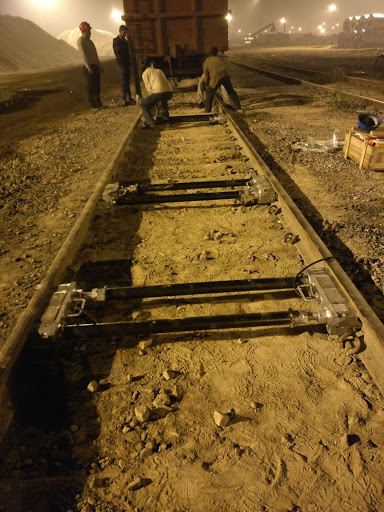Time is money in the fast-paced world of industrial operations and logistics. Vehicles must stop completely for traditional static weighing, which causes bottlenecks and lowers operating efficiency. Weigh-in-motion (WIM) devices, often referred to as in motion weighbridge, provide a ground-breaking solution by precisely weighing vehicles while they are moving. By doing away with time-consuming pauses, this innovation significantly boosts throughput and operational effectiveness. But putting these complex systems into place requires great thought and preparation. When purchasing an in-motion weighbridge solution for your business, this thorough article examines eight crucial considerations to take into account.
1.Speed Tolerance and Accuracy Trade-offs
Any in-motion weighbridge system is based on the link between vehicle speed and weighing accuracy. In general, dynamic forces, vibrations, and a shorter sensor contact time at higher speeds lead to decreased accuracy. The majority of commercial systems are designed to operate at speeds of up to 80 km/h for enforcement screening and 5–15 km/h for high precision applications. The maximum permitted speed should be determined by your particular accuracy needs. Think about whether screening-level accuracy (±5% to ±10%) is adequate or if trade-certified accuracy (usually ±0.5% to ±1%) is required. It’s important to keep in mind that if cars move far faster or slower than the acceptable speed range, even the most sophisticated system won’t be able to produce accurate results.
2.Surface Approach Quality and Evenness
Many operators overlook the importance of the approach segment that leads to your in-motion weighbridge in terms of measurement accuracy. Vehicles bounce or rock as they reach the weighing zone due to any bumps, depressions, or uneven surfaces, which introduces considerable measurement inaccuracies. For at least 20 meters before and after the weighing components, the approach should ideally be completely level, smooth, and made of hard materials. This approach zone has to be inspected and maintained on a regular basis, particularly in areas that experience freeze-thaw cycles or high rains that can erode the surface. While some sophisticated systems include algorithms that can partially adjust for small surface flaws, others have approach monitoring sensors that notify operators when surface conditions worsen beyond acceptable bounds.
3.Dynamic Load Cell Technology Selection
The load cell technology, which is the foundation of any mobile weighing bridge, needs to be especially made to manage dynamic loads as opposed to static measures. While specialized dynamic load cells use cutting-edge technology like hydraulic, fiber optic, or piezoelectric sensors to capture instantaneous forces, traditional strain gauge load cells sometimes have trouble with quick weight shifts. To record total axle weights independent of the lateral vehicle position, take into consideration systems that have many load cells spread over the weighing platform. In order to precisely record the weight profile as a vehicle passes, high-performance systems can collect thousands of measurements per second, making the sample rate very important. Because dynamic systems are frequently more vulnerable to external influences than their static equivalents, it is important to carefully consider temperature drift parameters.
4.Data Processing Algorithms and Filtering
Every precise in-motion weighbridge is powered by advanced signal processing software that converts unprocessed sensor data into useful weight readings. These algorithms adjust for changes in speed, correct for vehicle dynamics, and filter out vibrations. Machine learning techniques are used by advanced systems to constantly increase accuracy by identifying trends in your particular application. Inquire about the particular filtering methods used (e.g., Kalman filtering, moving average, or proprietary algorithms) and how well they work in your operating context when assessing systems. Equally crucial is the control system’s processing capacity, which dictates how fast results can be computed and shown. Accuracy in changing conditions may be maintained by systems with real-time calibration capabilities, which can adapt to environmental elements like temperature variations throughout the day.
5.Axle Detection and Vehicle Classification Capabilities
In addition to measuring the entire weight of a vehicle, modern in-motion weighbridges can also detect individual axles, measure axle spacing, and categorize vehicles based on their layout. This feature is crucial for regulatory compliance, particularly in cases where several vehicle classes are subject to varying weight restrictions. Even at greater speeds, sophisticated algorithms are able to discriminate between closely spaced axles on tandem or tridem groups. Think about if you require technologies that can identify particular aspects of your car, such as lift axles or specialist equipment. Reliability varies depending on the axle detecting technology, such as optical sensors, piezoelectric strips, or inductive loops. Instead of only being a weighing device, some systems can also combine with cameras for visual verification and record-keeping, resulting in a complete vehicle documentation system.
6.Environmental Resilience and Operating Conditions
Weighbridges in motion work under harsh conditions, including dust, vibration, severe weather, and even caustic substances. These systems, in contrast to indoor static scales, have to remain accurate in spite of these difficulties. Because electronics and load cells may wander greatly over large temperature ranges, temperature compensation is very crucial. Take into account each component’s IP (Ingress Protection) rating, particularly for installations in damp or dusty conditions. Sensor arrays are especially susceptible to electrical surges, hence lightning protection solutions are crucial for outdoor installations. Determine if the system requires further environmental controls, such as sunshades for tropical areas or heaters for cold settings. Long-term dependability in challenging environments is frequently determined by the strength of junction boxes and cable connections, thus these seemingly little parts merit close examination.
7.Integration with Traffic Management Systems
An in-motion weighbridge usually functions as a component of a broader traffic management ecosystem rather than functioning as a stand-alone device. Think about the way the system will work using automatic number plate recognition (ANPR) cameras, obstacles, traffic signals, and driver information screens. Overweight cars can be quickly identified for enforcement purposes through linkage with databases that include vehicle registration data. Fleet management software, ERP systems, and customer billing platforms may all be integrated with modern technology to establish smooth operating workflows. How well the weighbridge integrates with current infrastructure depends on the communication protocols it supports, whether they are proprietary or standard interfaces. Cloud connectivity makes it possible to monitor and report remotely from many places, converting raw weight data into useful business knowledge.
Conclusion
When done correctly, the substantial expenditure required to implement a lorry on board weighing systems may revolutionize operating efficiency. You can make sure your dynamic weighing system meets your unique operating needs and produces dependable results year after year by carefully addressing these eight important factors throughout the development stage. Keep in mind that working with seasoned suppliers that comprehend not just the technology but also how to use it in your particular market environment is frequently essential to effective deployment.



